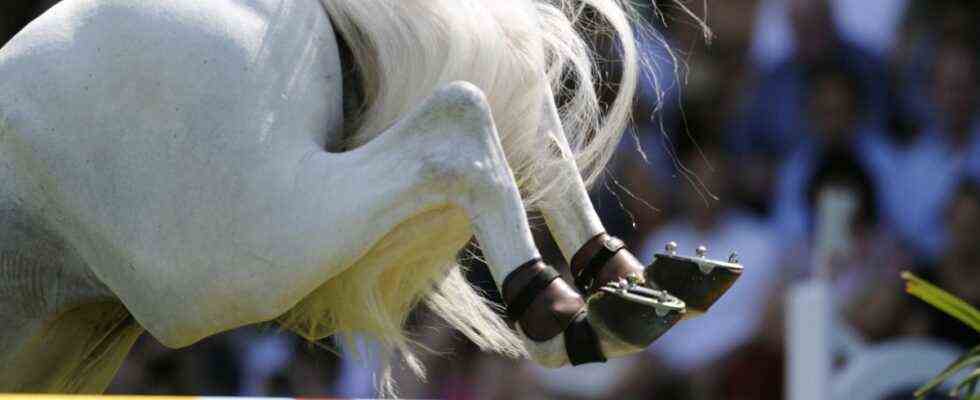Canturato sailed effortlessly over the obstacles, still without a rider on his back, but already with unmistakable talent. The gray horse was one of 70 young Holstein stallions that were recently registered in the Holstenhalle in Neumünster for this year’s licensing, the selection of future sport horse fathers. The two and a half year olds should show at this event whether they are good enough to pass on their genes. Two and a half years – that’s very young. Animal welfare and other associations find it too young. Growers and owners find it old enough to recognize the plants.
Such a young stallion is definitely a good investment. If it is licensed, it is worth a five- to six-figure amount. The most expensive stallion in Neumünster, Chavaros II, changed hands for 115,000 euros. Only a small percentage of each age group is allowed to work as a sire with the predicate “licensed”. There are later tests with riders, sometimes also in tournament sports.
But since the “Guidelines for Animal Welfare in Equestrian Sport”, initiated by the Federal Ministry of Agriculture, stipulate that a young riding horse must be at least 30 months, i.e. two and a half years, before training begins, and things have been fermenting in the horse breeding scene. Because there can no longer be a licensing in October, like in Neumünster. Most of the young stallions did not spend the summer on the pasture with their peers, as animal rights activists demand, but have been preparing for the licensing since spring, i.e. at the age of 24 months.
Then jumping is practiced without a rider and running in circles on the lunge. Many stallions are also likely to have become acquainted with the saddle. They spend many hours in the stables in individual boxes and are specially fed until, with their coiffed and shiny fur, they look like adult athletes and not the teenagers they actually are. “Child labor”, criticize some, “careful habituation”, appease others, depending on their interests. The German Equestrian Association (FN) grudgingly agreed to start training with 30 months. From next year, a few months later, between January and April, the licensing has to take place, sometimes even under the rider.
This year everything should be the same as before. But the responsible veterinary office in Neumünster thwarted the affected associations, Trakehners and Holsteiners. With reference to the guidelines, which have no legal force but are considered to be an early opinion in court, stallions born after June 1st should not be presented until a later date. This affected ten stallions among the Holsteiners – a bitter pill for the owners, because the sales opportunities are better in front of a fully occupied hall than later, when there is hardly any interested party.
Apparently there is a great deal of ingenuity when it comes to gaining an edge over the competition
After tough negotiations, the deadline was last postponed to June 15. That is why the aforementioned Canturato, born on June 13th, was allowed to show what he can do, while competitor Million Cent, who saw the light of day three days later, had to stay at home – it then seems more like a bureaucratic tug of war with animal welfare doesn’t have much to do.
But the medical officer was satisfied, appeared every day in the Holstenhalle and checked everything that could be checked. For the stallions born from May onwards, an official veterinary certificate had to prove physical and psychological maturity. It would be interesting to find out how official veterinarians, few of whom have to do with horses on a daily basis, but rather with pigs, cows and chickens, want to recognize the psychological maturity of a horse. You can’t have it drawn in small circles like the school psychologist did before starting school. An official veterinarian is a king in his district, he can have events canceled, and if there is suspicion of animal welfare violations, he can even move horses elsewhere without the owner knowing where.
It is a good thing that animal welfare is not a private matter for the horse owner. It is also good that agencies, including federal ministries, are thinking about how to protect horses from the sporting and financial ambitions of their riders and owners. Because the ingenuity is apparently limitless when it comes to achieving a better leap, a small advantage over the competition. A few weeks ago, the show jumper André Schröder was banned for a year because he was noticed during a tournament check with gaiters in which small, pointed pieces of iron were incorporated. This causes stabbing pain every time the bar is touched. Something like this has not yet been found at the licensing, but some licensing areas are already distributing standardized gaiters to the owners; your own may no longer be used.
They didn’t go that far in Holstein, but the stewards’ eyes were sharpened. Among the horse people from all over Europe who took a look at the 2019 vintage in Neumünster, there was also Land Oberstallmeister Astrid von Velsen. She couldn’t understand the excitement about the start of training: Her stallions and those of the southern German breeding associations have only been licensed in January for years. “Ours are still on the pasture, in groups,” says the boss of the main and state stud Marbach, “we won’t bring them into the stable until next week.” Then they’re still woolly and a little wild – but maybe a little happier too.

